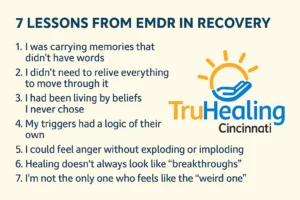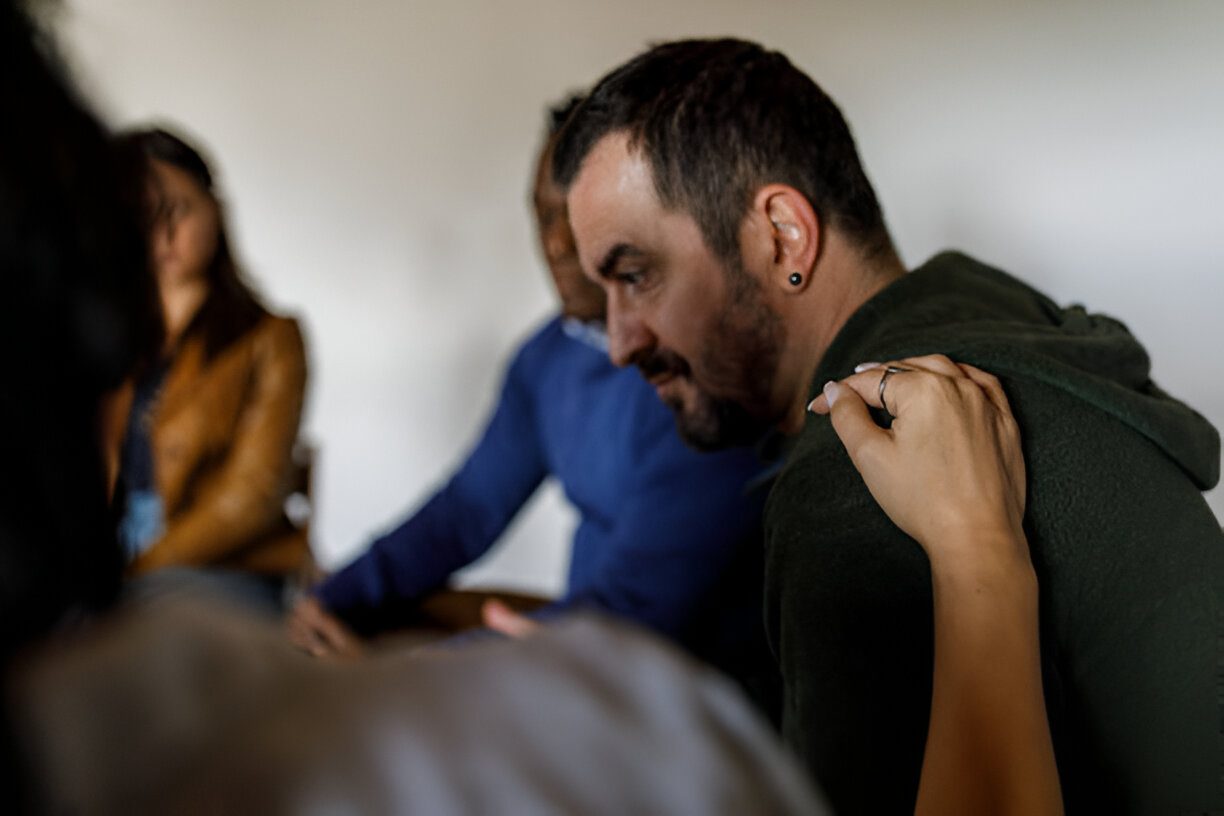When I first got sober, I thought the hard part would be saying no to the drink. Or the pills. Or whatever I had been using to avoid my own brain.
But the hardest part wasn’t quitting.
It was sitting still—without the noise, the fog, the blur—and realizing I didn’t really know who I was without the chaos.
Everyone told me to “just go to meetings” or “stay busy.”
And I did. But the ache underneath didn’t budge. The emotional flashbacks. The weird tension in my chest I couldn’t explain. The way I’d shut down when someone got too close.
So I started EMDR therapy.
Not because I believed in it.
But because I had run out of things that didn’t work.
At TruHealing Cincinnati, I found a kind of trauma therapy that didn’t make me explain myself a hundred times or rehash everything in perfect order. It let me start where I was: young, sober, awkward, and kind of scared of my own brain.
Here are seven things I learned about myself through EMDR in recovery—and why it changed everything.
1. I Was Carrying Memories That Didn’t Have Words
Some trauma doesn’t show up in clear flashbacks. It lives in your body. In reactions that feel disproportionate. In moments where you freeze or zone out and don’t really know why.
Before EMDR, I assumed I hadn’t been through “enough” to be struggling the way I was.
I didn’t remember big dramatic moments. I just knew certain things—like authority figures, loud arguments, being misunderstood—sent me into fight-or-flight mode.
EMDR gave me access to the feelings underneath, without needing a perfect storyline.
And once I let my nervous system lead, I found memories I hadn’t fully processed. Some were small on the surface—but massive in emotional weight.
2. I Didn’t Need to Relive Everything to Move Through It
The phrase “trauma therapy” made me nervous. I pictured crying through entire sessions, rehashing every detail, feeling worse before better.
But EMDR was different.
It used things like side-to-side eye movements and gentle prompts to help me process stuck emotions without having to retell everything.
I still felt things.
There were sessions where I cried, or left feeling raw.
But it wasn’t retraumatizing. It didn’t make me spiral.
It helped me shift how my body held those memories—until they stopped feeling like they defined me.
3. I Had Been Living By Beliefs I Never Chose
EMDR made me realize how many of my core beliefs weren’t actually mine.
Beliefs like:
- “I’m too much.”
- “I ruin everything.”
- “If I speak up, people will leave.”
- “Being needy is dangerous.”
None of those showed up in my conscious self-talk. But they were there—in how I avoided intimacy, in how I apologized constantly, in how I sabotaged good things.
Through EMDR, I traced these beliefs back to early moments: a teacher humiliating me, a parent withdrawing affection, being the “difficult” sibling.
And once I named them, I could start letting them go. Not overnight. But enough to start breathing differently.

4. My Triggers Had a Logic of Their Own
Before EMDR, I hated how easily I got “activated.”
Someone raising their voice. A sudden change of plans. Being ignored in a group.
I’d feel this hot, intense rush of shame or rage or fear—and then I’d shut down.
Through EMDR, I learned that these reactions weren’t signs that I was broken. They were protective responses I developed in environments that didn’t feel safe.
My body wasn’t wrong. It was just out of sync with where I was now.
And EMDR helped it catch up.
5. I Could Feel Anger Without Exploding or Imploding
This was big for me. I didn’t think I had anger.
Turns out, I had a lot of it—buried under shame.
In EMDR, I got in touch with the parts of me that felt violated, dismissed, or neglected—and I started to feel that heat in a new way.
It wasn’t destructive. It was clarifying.
I learned that anger could be fuel for boundaries.
That feeling it didn’t mean I was dangerous.
That honoring it actually made me more regulated—not less.
6. Healing Doesn’t Always Look Like “Breakthroughs”
Some weeks, EMDR felt quiet. I’d go in, do the work, leave without much to say.
And then—days later—I’d notice something.
I didn’t shut down in a hard conversation.
I didn’t numb out after a difficult memory.
I didn’t spiral when someone canceled plans.
These changes weren’t loud, but they were real.
And they added up to something I hadn’t felt in years: self-trust.
7. I’m Not the Only One Who Feels Like the “Weird One”
For a long time, I felt like a misfit in recovery. Too young. Too self-aware. Too emotional. Too quiet.
Like everyone else was buying into some Big Healing Narrative, and I was still lost in my own head.
But in EMDR, I got to be fully me—awkward, unsure, and in progress.
I didn’t have to “perform” recovery.
I just had to show up honestly.
Turns out, a lot of people feel like the “weird one.”
We’re just quiet about it.
What Is EMDR and Why Does It Work?
EMDR (Eye Movement Desensitization and Reprocessing) is a therapy approach designed to help people process and resolve distressing experiences.
It doesn’t require you to relive trauma in detail. Instead, it uses bilateral stimulation—like eye movements or tapping—to help your brain and body process stuck emotional content.
It works by reconnecting your emotional responses with your current reality. So your brain can stop reacting like you’re still in the past—and start responding from where you are now. Whether you’re local or looking for a EMDR therapy in Lexington, Kentucky or Louisville, Kentucky, we’ll help you find that sense of belonging.
FAQs About EMDR in Recovery
Can EMDR help with addiction-related trauma?
Yes. Many people in recovery use EMDR to work through the experiences that drove them to use—like childhood neglect, emotional abuse, or traumatic loss.
Do I have to remember every detail of my trauma for EMDR to work?
No. EMDR can be effective even if you don’t have full memory recall. It works with emotional and physical responses, not just verbal storytelling.
Is EMDR intense or overwhelming?
It can be emotional, but it’s structured and safe. A trained therapist guides you through the process at a pace that feels manageable for your system.
Can I do EMDR if I’m in early recovery?
Yes—with the right support. At TruHealing Cincinnati, we only begin EMDR when you have enough emotional stability and coping tools to engage with the work safely.
How long does EMDR take to work?
It depends. Some people feel shifts in a few sessions. Others work through deeper material over several months. The pace is tailored to your needs and goals.
Young, Sober, and Doing Deep Work? That’s Not Weird. That’s Brave.
If you’re early in recovery and feeling like the only one who still feels broken…
If you’ve tried therapy before but still feel stuck…
If you’re tired of dragging old pain into new relationships…
You are not alone.
And EMDR might be what helps things move again.
At TruHealing Cincinnati, we offer EMDR as part of our trauma therapy services. Whether you’re from the city or nearby areas, you’re welcome here.
It’s not about fixing you.
It’s about helping you finally feel safe enough to be yourself.
Want to learn more about EMDR and how it fits into recovery?
Call (888) 643-9118 or visit our trauma therapy to explore EMDR services in Cincinnati, Ohio.


